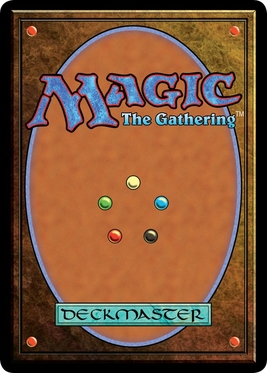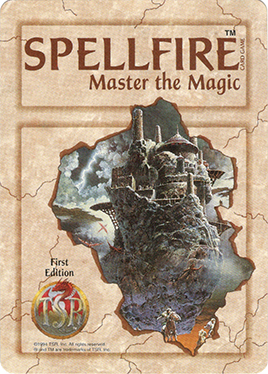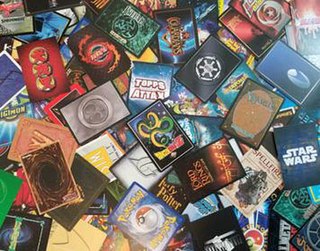
Magic: The Gathering is a tabletop and digital collectible card game created by Richard Garfield. Released in 1993 by Wizards of the Coast, Magic was the first trading card game and had approximately fifty million players as of February 2023. Over twenty billion Magic cards were produced in the period from 2008 to 2016, during which time it grew in popularity. As of the 2022 fiscal year, Magic generates over $1 billion in revenue annually.

Spellfire: Master the Magic is an out-of-print collectible card game (CCG) created by TSR, Inc. and based on their popular Dungeons & Dragons role playing game. The game appeared first in April 1994, shortly after the introduction of Magic: The Gathering, in the wake of the success enjoyed by trading card games. It was the second CCG to be released, preceding Wizards of the Coast's second CCG Jyhad by two months. More than one dozen expansions for the game were released, and the final expansion was released in October 1997.
Several video games based on the Magic: The Gathering franchise exist for multiple systems. Some have attempted to translate the card game to electronic play nearly exactly; others have taken more liberties and drawn more from the setting than the actual rules of the card game. Benefits of successful video game versions of the card game include convenience, practice, and challenge. However, artificial intelligence for a game such as Magic is an extremely hard problem, and such software usually must be continuously updated to stay current with recently released card sets. Video game versions often expand on artwork, and may include unique cards that rely on randomness, effects which would be difficult or annoying to duplicate in real life.

Duel Masters is a media franchise consisting of a manga, several anime series, a trading card game and several video games. It was originally associated with Magic: The Gathering, in which its cards are utilized within the manga. The original manga, accompanied with its sequels, sold 4.5 million copies in Japan.
The collectible card game Magic: The Gathering published seven expansion sets from 1993–1995, and one compilation set. These sets contained new cards that "expanded" on the base sets of Magic with their own mechanical theme and setting; these new cards could be played on their own, or mixed in with decks created from cards in the base sets. With Magic's runaway success, many of the printings of these early sets were too small to satisfy the rapidly growing fanbase. Cards from them became rare, hard to find, and expensive. It was not until Fallen Empires and Homelands that Wizards of the Coast was able to print enough cards to meet demand; additionally, Wizards of the Coast published Chronicles, a reprint set that helped fix many of the scarcity issues with the earliest sets.
Ice Age is a block of three expansion sets in Magic: The Gathering, consisting of the Ice Age, Alliances and Coldsnap sets. It is also the titular first set in the block. The Ice Age set is the eleventh set and the sixth expansion set, previewed at the Canadian Card and Comics Spectacular in early June 1995, and released later that month. Set in the years from 450 to 2934 AR, the set describes a world set in perpetual winter due to the events in Antiquities. Ice Age was followed up June 1996 with Alliances, the fourteenth Magic: The Gathering set and eighth expansion set.; and on July 21, 2006 with Coldsnap. The time period between Alliances and Coldsnap was the longest period of time between the beginning and the completion of a full block in Magic. Originally, the set Homelands, released in October 1995, was the second set in the Ice Age block, but following the release of Coldsnap, Homelands was removed from the block in favor of Coldsnap.
The collectible card game Magic: The Gathering published nine base sets from 1993–2007, also referred to as core sets. The base sets were considered descendants of the original Limited Edition, and shaped the default setting and feel of Magic. These sets consisted entirely of reprinted cards. These cards were generally simpler than cards in expansion sets, omitting multicolored cards, and used only the original abilities and keywords of Magic such as Flying and Trample. This simplicity led to many cards from these sets being considered "staples" of deck design. All cards were given a white border to mark them as reprints, with a few exceptions. From Fourth Edition in 1995 onward, a new base set would come out once per two years in the spring or early summer; for tournament play, that set would be legal for two years in the Standard format until the next core set replaced it.

Magic: The Gathering – Battlegrounds is a real time strategy video game developed by Secret Level and published by Atari It is based on Magic: The Gathering collectible card game, with many fundamental differences. The game is based on the creation of heroes and mages that summon forth powerful monsters, spells, and abilities to defeat the enemy duelist. Duelists learn new magical spells by completing the campaign, with more and more spell books becoming available as the player progresses. Each spell is separated into one of 5 colors, each with their own strengths and weaknesses.
Portal is the name given to the three Magic: The Gathering starter level sets. The original Portal was released on May 1, 1997, followed by Portal Second Age on June 24, 1998 and Portal Three Kingdoms on July 6, 1999. The Portal set was inspired by Chinese mythology; Three Kingdoms in particular by the 14th century Chinese historical novel Romance of the Three Kingdoms by Luo Guanzhong.
The collectible card game Magic: The Gathering has released compilation sets, reprint sets, and box sets over its history. These are distinct from core sets and expansion sets, the most heavily marketed sources of new cards. With the exception of Chronicles, reprint sets generally do not affect tournament legality in supported formats; for example, cards reprinted in the Modern Masters reprint set, while legal for tournament play, did not necessarily cause the card to be included in the "Standard" environment.
Magic: The Gathering formats are various ways in which the Magic: The Gathering collectible card game can be played. Each format provides rules for deck construction and gameplay, with many confining the pool of permitted cards to those released in a specified group of Magic card sets. The Wizards Play Network, the governing body that oversees official Magic competitive play, categorizes its tournament formats into Constructed and Limited. Additionally, there are many casual formats with the Commander format being one of the most popular formats of the game.

Magic: The Gathering is a video game published by MicroProse in March 1997 based on the collectible card game Magic: The Gathering. It is often referred to as Shandalar after the plane of Shandalar, where the game takes place. The player must travel the land and fight random enemies to gain cards, and defeat five wizards representing the five colors. The player must prevent one color from gaining too much power, and defeat the planeswalker Arzakon, who has a deck of all five colors. Adventure and role-playing elements are present, including inventory, gold, towns, dungeons, random battles, and character progression in the form of new abilities and a higher life point total. An oversized version of Aswan Jaguar was included in the game box.
The rules of Magic: The Gathering were originally developed by the game's creator, Richard Garfield, and accompanied the first version of the game in 1993. The rules of Magic have been changed frequently over the years by the manufacturer, Wizards of the Coast, mostly in minor ways. However, major rules overhauls have also been done a few times.

A collectible card game (CCG), also called a trading card game (TCG) among other names, is a type of card game that mixes strategic deck building elements with features of trading cards. It was introduced with Magic: The Gathering in 1993.

Magic: The Gathering – Duels of the Planeswalkers 2012 is a video game based on the popular collectible card game of the same name, published by Wizards of the Coast. It was released on June 15, 2011. The game is a follow-up to the highly popular Magic: The Gathering – Duels of the Planeswalkers, which was released in 2009. An expansion for the game, called Ascend into Darkness, was released on September 14, 2011. The sequel, Magic: The Gathering – Duels of the Planeswalkers 2013, was released in 2012.

Magic: The Gathering – Duels of the Planeswalkers 2013 is a video game based on the popular collectible card game of the same name, first published by Wizards of the Coast in 1993. The game was released on June 20, 2012, via Steam, Xbox Live Arcade, the PlayStation Network, and iPad, and is the third game in the Magic: The Gathering – Duels of the Planeswalkers series. The gameplay follows that of the original card game, however within a more restrained framework. It received mainly positive reviews and was number one in the PlayStation Network sales for June. The sequel, Magic: The Gathering – Duels of the Planeswalkers 2014, was released in 2013.

The BattleTech Trading Card Game is an out-of-print collectible card game (CCG) set in the BattleTech universe. The game was developed by Wizards of the Coast (WotC) for FASA and released in 1996.
The Artifacts Cycle is a tetralogy of Magic: The Gathering expansion sets centered on the exploits of Urza Planeswalker. It consists of the expansions Antiquities, Urza's Saga, Urza's Legacy and Urza's Destiny. The latter three sets are sometimes referred to as an "Urza block" for tournament purposes, since there have been formats and time periods in which cards from the later three sets were legal but cards from Antiquities were not. However, the books "The Brothers' War", "Planeswalker", "Timestreams", and "Bloodlines" unambiguously confirm that, from a story and thematic point of view, "Artifacts cycle" is correct and it begins with the events depicted in Antiquities.
A sideboard, side deck, or side is a set of cards in a collectible card game that are separate from a player's primary deck. It is used to customize a match strategy against an opponent by enabling a player to change the composition of the playing deck.

Magic Duels is a video game based on the popular collectible card game Magic: The Gathering. Magic Duels is a successor to Stainless Games' Magic: The Gathering – Duels of the Planeswalkers and its annual sequels, released from 2009 through 2014. The free-to-play title was released on July 29, 2015, shortly following the physical release of the Magic Origins core set.










